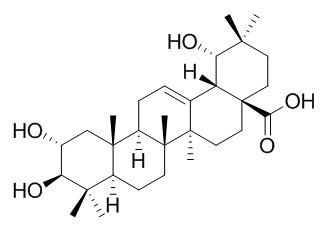Arjunic acid
Arjunic acid is a strong antioxidant and a free radical scavenger.
Arjunic acid shows activity against Gram-positive and Gram-negative bacteria with MIC values ranging between 1.9 and 15.6 microg/mL.
Inquire / Order:
manager@chemfaces.com
Technical Inquiries:
service@chemfaces.com
Tel:
+86-27-84237783
Fax:
+86-27-84254680
Address:
1 Building, No. 83, CheCheng Rd., Wuhan Economic and Technological Development Zone, Wuhan, Hubei 430056, PRC
Providing storage is as stated on the product vial and the vial is kept tightly sealed, the product can be stored for up to
24 months(2-8C).
Wherever possible, you should prepare and use solutions on the same day. However, if you need to make up stock solutions in advance, we recommend that you store the solution as aliquots in tightly sealed vials at -20C. Generally, these will be useable for up to two weeks. Before use, and prior to opening the vial we recommend that you allow your product to equilibrate to room temperature for at least 1 hour.
Need more advice on solubility, usage and handling? Please email to: service@chemfaces.com
The packaging of the product may have turned upside down during transportation, resulting in the natural compounds adhering to the neck or cap of the vial. take the vial out of its packaging and gently shake to let the compounds fall to the bottom of the vial. for liquid products, centrifuge at 200-500 RPM to gather the liquid at the bottom of the vial. try to avoid loss or contamination during handling.
J Sep Sci.2019, 42(21):3352-3362
Adv. Anim. Vet. Sci.2024, 12(5):986-993.
Evid Based Complement Alternat Med.2021, 8855980.
Environ Toxicol.2020, doi: 10.1002
J. Essential Oil Research2024, 6:36:554-565.
Journal of Food Hygiene and Safety2019, 34(5):413-420
Curr Top Med Chem.2020, 20(21):1898-1909.
Phytomedicine.2019, 55:229-237
Appl. Sci.2023, 13(17), 9653.
Integr Cancer Ther.2018, 17(3):832-843
Related and Featured Products
Am J Chin Med. 2008;36(1):197-207.
Arjunic acid, a strong free radical scavenger from Terminalia arjuna.[Pubmed:
18306462]
This study was designed to investigate the antioxidant and free radical scavenging capacities of Arjunic acid, an aglycone obtained from the fruit of medicine Terminalia Fruit.
METHODS AND RESULTS:
Liver microsomes, mitochondria, and red blood cells (RBCs) were prepared from Wistar rats. The antioxidant capacity was determined by the inhibitory effect on lipid peroxidation, hydrogen peroxide induced RBCs hemolysis, and RBCs autoxidative hemolysis. The free radical scavenging activity was tested by DPPH method and 2',7'-dichlorodihydrofluoresc in diacetate (DCFH(2)-DA) assay. Ascorbic acid was chosen as the positive controls. Results showed that Arjunic acid was a strong antioxidant and a free radical scavenger, more potent than ascorbic acid, in microsomes lipid peroxidation, DPPH, hydrogen peroxide induced RBCs hemolysis, and (DCFH(2)-DA) assay (p < 0.05). However, no significant difference was observed in the RBCs autoxidative hemolysis assay (p > 0.05).
Planta Med. 2008 Mar;74(4):411-3.
Isolation and biological activities of termilignan B and arjunic acid from Terminalia sericea roots.[Pubmed:
18484533]
Bioassay-guided fractionation of ethyl acetate root extracts of Terminalia sericea yielded a new compound, termilignan B, and the known Arjunic acid.
METHODS AND RESULTS:
Both compounds showed activity against Gram-positive and Gram-negative bacteria with MIC values ranging between 1.9 and 15.6 microg/mL. The lowest MIC value (1.9 microg/mL) was observed with termilignan B against Bacillus subtilis. Neither of the compounds showed significant activity against Mycobacterium aurum A+. In the cyclooxygenase assays, the compounds showed weak inhibitory activity with IC (50) values of 78 microM (COX-1) and 156 microM (COX-2) (termilignan B) and 36 microM (COX-1) and 253 microM (COX-2) (Arjunic acid). No potential mutagenic effects were observed with the two compounds in the Salmonella microsome assay (TA 98).



